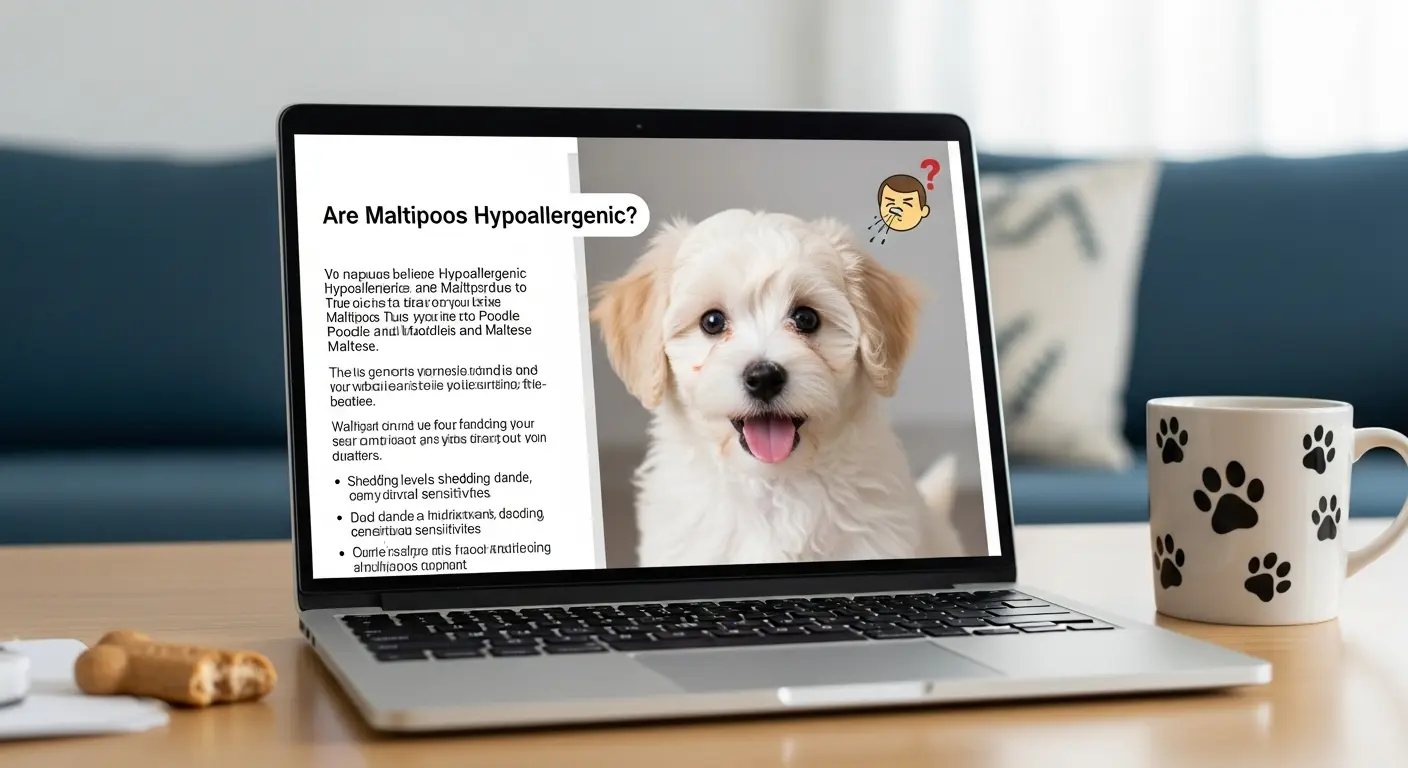The Truth About Maltipoos: Are They Truly Hypoallergenic?

What Does "Hypoallergenic" Actually Mean for Dogs?
If you're an allergy sufferer who dreams of having a dog, the word "hypoallergenic" probably feels like a magic word. It conjures up images of happy, sneeze-free cuddles on the couch and a furry companion without the watery eyes and itchy throat. It’s the golden ticket, right?
Well, let’s clear the air a little. Here’s the honest, simple truth: no dog is 100% hypoallergenic.
It’s a bit of a shocker, but it’s an important place to start. The reason is that people aren't typically allergic to a dog's hair itself. The real culprits are tiny, invisible proteins found in a dog’s dander (flakes of dead skin, like doggy dandruff), saliva, and urine. When a dog sheds, that dander and the dried saliva on its fur get released into the air, onto your furniture, and all over your home.
So, when we call a dog "hypoallergenic," what we really mean is that they are low-allergen. These breeds have a special type of coat that dramatically reduces the spread of those pesky allergens.
Think of it this way:
-
Imagine dander is like glitter. A heavy-shedding dog is like a craft project gone wild—the glitter gets everywhere. It floats in the air, settles on every surface, and is impossible to get rid of.
-
A "hypoallergenic" dog, like the Maltipoo, is different. Their coat is more like a piece of tape. The glitter (dander) is still there, but it gets trapped in their soft, hair-like coat instead of being released into your environment with every wag of their tail. Because they shed very little, you have far more control over where the allergens go.
So, while the term might be a little misleading, it points us toward breeds that are significantly better for allergy sufferers. It’s not a promise of zero reactions, but it’s a massive step in the right direction. And this is exactly where the wonderful Maltipoo begins to shine.
The Poodle & Maltese Heritage: The Secret to the Maltipoo's Low-Allergen Coat
So, what's the secret sauce? How did the Maltipoo win the genetic lottery to become such a fantastic companion for people with allergies? The answer lies in its wonderful, world-class heritage: the intelligent Poodle and the elegant Maltese. This isn't an accident; it's the result of combining two of the best low-shedding coats in the dog world.
Let's break down this perfect pairing:
The Poodle's Contribution: The "Dander Trap" Coat
Think of the iconic Poodle. Beyond their famously clever minds and sophisticated looks, their real superpower lies in their coat. It’s not fur; it’s a dense, curly hair that grows continuously, much like our own. This unique texture is the first piece of the hypoallergenic puzzle.
The Poodle's curls act like a natural net. Instead of shedding loose hair and dander all over your home, the dead hair gets trapped within the surrounding coat. It doesn’t fall out easily, which means fewer allergens floating around in the air you breathe. This is precisely why Poodles have long been the go-to breed for allergy sufferers.
The Maltese's Contribution: The "No Undercoat" Advantage
On the other side of the family tree, you have the glamorous Maltese. With their long, flowing white coat, they look like pure royalty. But their secret weapon against allergies is something you can't see: they are a single-coated breed.
Many dog breeds have a double coat—a soft, dense undercoat for insulation and a tougher outer coat. This undercoat is what they "blow" seasonally, creating a storm of fur and dander that can be a nightmare for anyone with allergies. The Maltese, with its single layer of silky hair, simply doesn't have this problem. They shed minimally, all year round.
The Maltipoo: The Best of Both Worlds
Now, imagine taking the best qualities from both of these incredible coats and blending them together. That’s the magic of the Maltipoo!
They inherit the low-shedding, hair-like quality from both the Poodle and the Maltese, giving you a double dose of allergy-friendly goodness. Whether their coat ends up wavy like a gentle sea or curly like their Poodle parent, the underlying principle is the same: the hair and dander stay put, waiting to be brushed out by you rather than being sprinkled all over your furniture.
This incredible heritage is the very reason Maltipoos are not just cute faces—they are thoughtfully bred companions perfect for a sneeze-free home.

Grooming and Home Care: How to Minimize Allergens with a Maltipoo
Having a Maltipoo gives you a fantastic head start in the fight against allergies. But think of it as a partnership! Their low-shedding coat does most of the heavy lifting, and with a few simple habits, you can do your part to create a truly sneeze-free sanctuary for you both.
This isn't about endless chores; it's about smart, simple routines that make a world of difference. Here's your game plan for a happy, low-allergen home.
1. Brushing is Your Best Friend
This is your number one, non-negotiable secret weapon. Remember how we said the Maltipoo's coat traps dander and loose hair? Brushing is how you safely remove it before it has a chance to escape into your home.
- How Often: Aim for a quick brush session at least 3-4 times a week. Daily is even better!
- The Goal: You're not just detangling; you're gently pulling out the trapped allergens. This simple 5-minute routine prevents buildup and keeps their coat healthy and your air clean.
2. The Right Bathing Schedule
A bath is like a reset button, washing away any accumulated dander, pollen, and dried saliva from their coat. But more is not always better.
- The Sweet Spot: Bathing your Maltipoo every 3 to 4 weeks is usually perfect.
- Why Not More Often? Over-bathing can strip the natural oils from their skin, leading to dryness. And dry skin can mean more dander. Always use a gentle, high-quality dog shampoo.
3. Professional Grooming is a Game-Changer
That adorable "teddy bear" look isn't just for style points! Keeping your Maltipoo's hair clipped shorter is incredibly practical for allergy sufferers.
- Frequency: A trip to a professional groomer every 6 to 8 weeks is a great investment.
- The Benefit: Shorter hair means less surface area for allergens to cling to. It’s also easier for you to brush and keep clean between grooming appointments.
4. Create an Allergy-Friendly Haven
Your dog's care is only half the battle; your home environment is the other half.
- Wash Their Bedding Regularly: Your Maltipoo’s bed is an allergen hotspot. Toss it in the wash on a hot cycle at least once a week.
- Invest in a HEPA Filter: A good quality air purifier with a HEPA filter can work wonders by capturing airborne dander before it settles.
- Make Your Bedroom a "No-Dog" Zone: This can be tough, we know! But giving yourself an 8-hour, allergen-free sanctuary to sleep in can dramatically reduce your overall symptoms.
- Regular Cleaning: Frequent vacuuming (ideally with a HEPA-filter vacuum) and wiping down surfaces will keep allergens from building up.
By teaming up with your Maltipoo, you're not just managing allergies—you're creating a lifestyle that allows you to enjoy every single cuddle and playtime moment without reaching for the tissues.
The Final Verdict: Is a Maltipoo the Right Dog for Your Allergies?
So, we’ve journeyed through the science of dander and the wonderful world of Poodle and Maltese genetics. It all comes down to one big question: Is a Maltipoo the right dog to bring into your life, especially if sniffles and sneezes are a constant worry?
The final verdict? For the vast majority of allergy sufferers, the answer is a resounding, hopeful yes. But with a small, important asterisk.
Thanks to their incredible Poodle and Maltese heritage, Maltipoos are genetically designed to be low-allergen partners. Their beautiful, hair-like coat is a master at trapping dander, preventing those pesky allergens from taking over your home and your sinuses. When you combine that natural advantage with a consistent grooming and cleaning routine, you create an environment where a dog and an allergy-sufferer can live together in harmony.
But here is that all-important asterisk—the final piece of advice we can give you.
Before you fall head-over-heels in love (which is incredibly easy to do!), there is one final, crucial step: Spend time with a Maltipoo.
Allergies are deeply personal. While Maltipoos are a fantastic option for most, the only way to know for certain how your body will react is to have some real-world interaction. If you can, visit a reputable breeder or spend an afternoon with a friend who owns a Maltipoo. Pet them, play with them, and pay close attention to how you feel. Think of it as a test cuddle—you need to know if it’s the right fit for you.
So, is a Maltipoo the right dog for your allergies?
If you're looking for a companion that offers you the absolute best chance at a life full of joy, licks, and cuddles without the compromise of constant allergies, the Maltipoo is, without a doubt, one of the top contenders in the world. They aren't a 100% guaranteed, magic solution, but they are a wonderful, loving, and intelligent chance at the sneeze-free companionship you've been dreaming of.